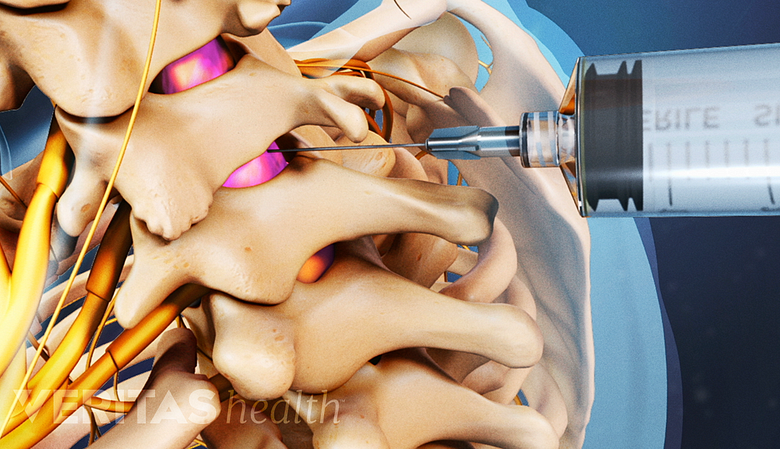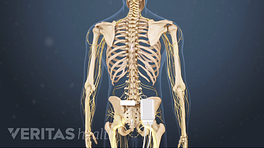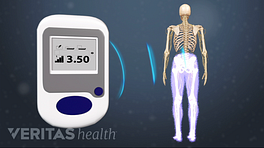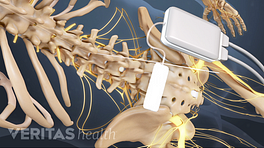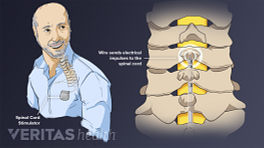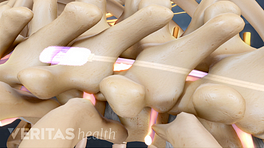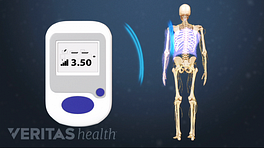Rechargeable SCS is typically recommended if the following conditions have been met:
- Chronic pain still significantly lowers quality of life after more than 6 months of nonsurgical treatments
- The pain is caused by a problem that is likely to respond well to SCS
- The patient is capable of charging the device on a regular basis
- The appeal of fewer surgeries over time to replace batteries is compelling
If these conditions are met, a device that has rechargeable capability will be tried for 5 to 7 days to see whether a permanent implant would likely succeed or not.
With recent advances in technology for SCS-related pain relief, many batteries are seeing increasing power requirements. Therefore, some new devices only offer rechargeable systems (a non-rechargeable or primary cell would have too short of a lifespan and require frequent surgeries). It is important to consider battery options as a secondary choice after considering which device has the most potential for pain relief.
Also, some SCS devices offer a choice between a non-rechargeable or rechargeable battery. In such cases, the rechargeable battery may be smaller in addition to lasting longer.
In This Article:
- Rechargeable Spinal Cord Stimulators for Chronic Pain
- When to Consider Getting a Rechargeable SCS
- Recharging a Rechargeable SCS
- Risks of Rechargeable SCS
Treatments to Try Before Getting a Rechargeable SCS
The procedure to implant an SCS device in the body carries some small but significant risks, such as infection, allergic reaction, spinal cord injury, worsening pain, and others. It is important to try several types of nonsurgical treatments before SCS, such as:
Medications
NSAIDs provide anti-inflammatory effects and help calm inflammation and pain in the back.
Examples of medications that may be tried for chronic pain include acetaminophen, nonsteroidal anti-inflammatory drugs (NSAIDs), opioids, muscle relaxants, antidepressants, or others. Care must be taken with pain medications to avoid dangerous overdoses or side effects. Some medications, such as opioids, have the added risk of potentially becoming addictive and are only recommended for short-term use or painful flare-ups.
See Medications for Back Pain and Neck Pain
Lifestyle changes
Depending on the type of pain, changes in daily routines or habits may help provide relief. Examples include switching to an anti-inflammatory diet, quitting nicotine, increasing activity levels, or avoiding/modifying movements that are particularly painful.
Physical therapy
A program of strengthening and stretching the neck, back, and core muscles may help relieve chronic pain that stems from the spine. A physical therapist or other trained medical professional can tailor a program for the patient’s specific needs.
Read more about Physical Therapy
Alternative treatments
Some patients report finding relief from chronic pain by trying alternative treatments, such as chiropractic manipulations, massage therapy, acupuncture, or mindful meditation.
Read more about Alternative Care
Injections
Epidural steroid injections reduce inflammation and control painful symptoms.
Various types of injections may be tried to reduce spinal pain and inflammation, such as nerve blocks or epidural steroid injections.
See Injections for Neck and Back Pain Relief
In addition, candidates for SCS must complete a psychological evaluation to screen for untreated anxiety, depression, or other mental health issues.
SCS Pain Relief Trial
Once the decision is made to try a spinal cord stimulator, a trial period is performed to see if the device will provide the desired amount of pain relief. Typically, the SCS device’s leads are inserted into the spinal column and placed near the pain source(s) while the pulse generator is temporarily attached to the skin, but not implanted. The trial period lasts 5 to 7 days on average. If at least 50% pain reduction is achieved, the decision is commonly made to implant the SCS device permanently.
Cost of Rechargeable Spinal Cord Stimulators
As technology and health care continue to rapidly change, it is difficult to accurately estimate the current and future costs of rechargeable spinal cord stimulators. A small study published in 2009 found that the average cost to implant an SCS device in the U.S. was between $33,000 and $58,000. 1 Kumar K, Bishop S. Financial impact of spinal cord stimulation on the healthcare budget: a comparative analysis of costs in Canada and the United States. Journal of Neurosurgery: Spine. 2009; 10(6): 564-73. In general, rechargeable SCS devices tend to be mildly more expensive than traditional SCS, but the rechargeable SCS has the potential to be more cost-effective if fewer replacement surgeries are needed.
Typically, insurance companies cover most of the costs associated with SCS if the procedure is deemed medically necessary. While the upfront costs can vary considerably based on the product type and which insurance provider is paying, it should be noted that annual maintenance can be unexpectedly costly if complications arise. Generally, in the United States, there is no discernible cost difference to the patient with a rechargeable vs. non-rechargeable system.
Data is still being collected on the cost-effectiveness of rechargeable SCS, as well as SCS in general. In addition to SCS costs, many other factors must be taken into consideration. For example, successful SCS treatment may reduce costs of other treatments that had been used to manage pain, such as medications.
- 1 Kumar K, Bishop S. Financial impact of spinal cord stimulation on the healthcare budget: a comparative analysis of costs in Canada and the United States. Journal of Neurosurgery: Spine. 2009; 10(6): 564-73.

